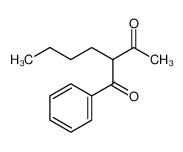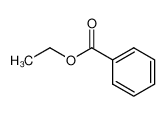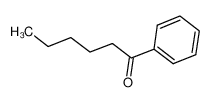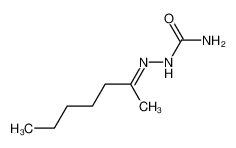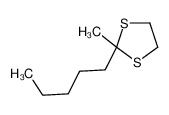1.Identification
1.1 GHS Product identifier
| Product name | heptan-2-one |
|---|
1.2 Other means of identification
| Product number | - |
|---|---|
| Other names | Amyl Methyl Ketone |
1.3 Recommended use of the chemical and restrictions on use
| Identified uses | For industry use only. Food additives -> Flavoring Agents |
|---|---|
| Uses advised against | no data available |
1.4 Supplier's details
| Company | MOLBASE (Shanghai) Biotechnology Co., Ltd. |
|---|---|
| Address | Floor 4 & 5, Building 12, No. 1001 North Qinzhou Road, Xuhui District, Shanghai, China |
| Telephone | +86(21)64956998 |
| Fax | +86(21)54365166 |
1.5 Emergency phone number
| Emergency phone number | +86-400-6021-666 |
|---|---|
| Service hours | Monday to Friday, 9am-5pm (Standard time zone: UTC/GMT +8 hours). |
2.Hazard identification
2.1 Classification of the substance or mixture
Flammable liquids, Category 3
Acute toxicity - Oral, Category 4
Acute toxicity - Inhalation, Category 4
2.2 GHS label elements, including precautionary statements
| Pictogram(s) |   |
|---|---|
| Signal word | Warning |
| Hazard statement(s) | H226 Flammable liquid and vapour H302 Harmful if swallowed H332 Harmful if inhaled |
| Precautionary statement(s) | |
| Prevention | P210 Keep away from heat, hot surfaces, sparks, open flames and other ignition sources. No smoking. P233 Keep container tightly closed. P240 Ground and bond container and receiving equipment. P241 Use explosion-proof [electrical/ventilating/lighting/...] equipment. P242 Use non-sparking tools. P243 Take action to prevent static discharges. P280 Wear protective gloves/protective clothing/eye protection/face protection. P264 Wash ... thoroughly after handling. P270 Do not eat, drink or smoke when using this product. P261 Avoid breathing dust/fume/gas/mist/vapours/spray. P271 Use only outdoors or in a well-ventilated area. |
| Response | P303+P361+P353 IF ON SKIN (or hair): Take off immediately all contaminated clothing. Rinse skin with water [or shower]. P370+P378 In case of fire: Use ... to extinguish. P301+P312 IF SWALLOWED: Call a POISON CENTER/doctor/…if you feel unwell. P330 Rinse mouth. P304+P340 IF INHALED: Remove person to fresh air and keep comfortable for breathing. P312 Call a POISON CENTER/doctor/…if you feel unwell. |
| Storage | P403+P235 Store in a well-ventilated place. Keep cool. |
| Disposal | P501 Dispose of contents/container to ... |
2.3 Other hazards which do not result in classification
none
3.Composition/information on ingredients
3.1 Substances
| Chemical name | Common names and synonyms | CAS number | EC number | Concentration |
|---|---|---|---|---|
| heptan-2-one | heptan-2-one | 110-43-0 | none | 100% |
4.First-aid measures
4.1 Description of necessary first-aid measures
General advice
Consult a physician. Show this safety data sheet to the doctor in attendance.
If inhaled
Fresh air, rest. Refer for medical attention.
In case of skin contact
Remove contaminated clothes. Rinse skin with plenty of water or shower.
In case of eye contact
First rinse with plenty of water for several minutes (remove contact lenses if easily possible), then refer for medical attention.
If swallowed
Rinse mouth.
4.2 Most important symptoms/effects, acute and delayed
Inhalation can cause headache, fatigue, nausea, vomiting, dizziness, stupor, drowsiness, disturbed vision, and unconsciousness. Skin contact can cause moderate irritation, defatting, and dermatitis. Ingestion may cause irritation of lips and mouth, gastro-intestinal irritation, nausea, diarrhea, drowsiness, loss of consciousness, weak and rapid pulse, cold-pale complexion. (USCG, 1999)
4.3 Indication of immediate medical attention and special treatment needed, if necessary
Basic treatment: Establish a patent airway. Suction if necessary. Watch for signs of respiratory insufficiency and assist ventilations if necessary. Administer oxygen by nonrebreather mask at 10 to 15 L/min. Monitor for pulmonary edema and treat if necessary ... . For contamination, flush eyes immediately with water. Irrigate each eye continuously with normal saline during transport ... . Do not use emetics. For ingestion, rinse mouth and administer 5 ml/kg up to 200 ml of water for dilution if the patient can swallow, has a strong gag reflex, and does not drool. Administer activated charcoal ... . /Ketones and related compounds/
5.Fire-fighting measures
5.1 Extinguishing media
Suitable extinguishing media
To fight fire, use foam, carbon dioxide, dry chemical.
5.2 Specific hazards arising from the chemical
Special Hazards of Combustion Products: Irritating vapors and toxic gases, such as carbon dioxide and carbon monoxide, may be formed when involved in fire. Behavior in Fire: Closed containers may explode when exposed to extreme heat. (USCG, 1999)
5.3 Special protective actions for fire-fighters
Wear self-contained breathing apparatus for firefighting if necessary.
6.Accidental release measures
6.1 Personal precautions, protective equipment and emergency procedures
Use personal protective equipment. Avoid dust formation. Avoid breathing vapours, mist or gas. Ensure adequate ventilation. Evacuate personnel to safe areas. Avoid breathing dust. For personal protection see section 8.
6.2 Environmental precautions
Personal protection: filter respirator for organic gases and vapours adapted to the airborne concentration of the substance. Ventilation. Collect leaking and spilled liquid in sealable metal containers as far as possible. Absorb remaining liquid in dry sand or inert absorbent. Then store and dispose of according to local regulations. Do NOT wash away into sewer.
6.3 Methods and materials for containment and cleaning up
Pick up and arrange disposal. Sweep up and shovel. Keep in suitable, closed containers for disposal.
7.Handling and storage
7.1 Precautions for safe handling
Avoid contact with skin and eyes. Avoid formation of dust and aerosols. Avoid exposure - obtain special instructions before use.Provide appropriate exhaust ventilation at places where dust is formed. For precautions see section 2.2.
7.2 Conditions for safe storage, including any incompatibilities
Fireproof.
8.Exposure controls/personal protection
8.1 Control parameters
Occupational Exposure limit values
Recommended Exposure Limit: 10 Hr Time-Weighted Avg: 100 ppm (465 mg/cu m).
Biological limit values
no data available
8.2 Appropriate engineering controls
Handle in accordance with good industrial hygiene and safety practice. Wash hands before breaks and at the end of workday.
8.3 Individual protection measures, such as personal protective equipment (PPE)
Eye/face protection
Safety glasses with side-shields conforming to EN166. Use equipment for eye protection tested and approved under appropriate government standards such as NIOSH (US) or EN 166(EU).
Skin protection
Wear impervious clothing. The type of protective equipment must be selected according to the concentration and amount of the dangerous substance at the specific workplace. Handle with gloves. Gloves must be inspected prior to use. Use proper glove removal technique(without touching glove's outer surface) to avoid skin contact with this product. Dispose of contaminated gloves after use in accordance with applicable laws and good laboratory practices. Wash and dry hands. The selected protective gloves have to satisfy the specifications of EU Directive 89/686/EEC and the standard EN 374 derived from it.
Respiratory protection
Wear dust mask when handling large quantities.
Thermal hazards
no data available
9.Physical and chemical properties
| Physical state | colorless liquid |
|---|---|
| Colour | Colorless to white liquid |
| Odour | Penetrating fruity odor |
| Melting point/ freezing point | -36°C(lit.) |
| Boiling point or initial boiling point and boiling range | 149-150°C(lit.) |
| Flammability | Class II Combustible Liquid: Fl.P. at or above 37.78°C and below 60°C.Flammable. |
| Lower and upper explosion limit / flammability limit | Lower flammable limit: 1.1% by volume at 151 deg F (66°C); Upper flammable limit: 7.9% by volume at 250 deg F (121°C) |
| Flash point | 41°C |
| Auto-ignition temperature | 392.78°C |
| Decomposition temperature | no data available |
| pH | no data available |
| Kinematic viscosity | 0.77 cP |
| Solubility | In water:4.3 g/L (20 ºC) |
| Partition coefficient n-octanol/water (log value) | log Kow = 1.98 |
| Vapour pressure | 2.14 mm Hg ( 20 °C) |
| Density and/or relative density | 0.82g/mLat 25°C(lit.) |
| Relative vapour density | 3.94 (vs air) |
| Particle characteristics | no data available |
10.Stability and reactivity
10.1 Reactivity
no data available
10.2 Chemical stability
Low volatility
10.3 Possibility of hazardous reactions
A flammable liquid when exposed to heat or flame ...N-AMYL METHYL KETONE reacts exothermically with many acids and bases to produce flammable gases (e.g., H2). The heat may be sufficient to start a fire in the unreacted portion. Reacts with reducing agents such as hydrides, alkali metals, and nitrides to produce flammable gas and heat. Incompatible with isocyanates, aldehydes, cyanides, peroxides, and anhydrides. Incompatible with many oxidizing agents including nitric acid, nitric acid/hydrogen peroxide mixture, and perchloric acid. May form peroxides (USCG, 1999).
10.4 Conditions to avoid
no data available
10.5 Incompatible materials
Strong acids, alkalis, and oxidizers (Note: Will attack some forms of plastic).
10.6 Hazardous decomposition products
When heated to decomposition it emits acrid smoke and irritating fumes.
11.Toxicological information
Acute toxicity
- Oral: LD50 Rat oral 1.670 g/kg
- Inhalation: no data available
- Dermal: no data available
Skin corrosion/irritation
no data available
Serious eye damage/irritation
no data available
Respiratory or skin sensitization
no data available
Germ cell mutagenicity
no data available
Carcinogenicity
no data available
Reproductive toxicity
no data available
STOT-single exposure
no data available
STOT-repeated exposure
no data available
Aspiration hazard
no data available
12.Ecological information
12.1 Toxicity
- Toxicity to fish: LC50 Pimephales promelas (Fathead minnow) 131 mg/L/96 hr (confidence limit 126-137 mg/L), flow-through bioassay with measured concentrations, 24.2°C, dissolved oxygen 7.2 mg/L, hardness 46.4 mg/L calcium carbonate, alkalinity 42.1 mg/L calcium carbonate, and pH 7.72.
- Toxicity to daphnia and other aquatic invertebrates: no data available
- Toxicity to algae: no data available
- Toxicity to microorganisms: no data available
12.2 Persistence and degradability
AEROBIC: 2-Heptanone was found to undergo aerobic oxidation after a short lag period when inoculated with an unactivated sewage sludge seed(1). 2-Heptanone had a theoretical biological oxygen demand (BOD) of 1.4%, 2.4% and 4.8% after 6, 12 and 24 hr, respectively, when incubated with an activated sludge seed at an initial concentration of 500 ppm(2). 2-Heptanone underwent a 5 day theoretical BOD of 44%(3). In a screening study using a sewage seed, 2-heptanone had a 10 day BOD of 0.50 g/g(4). 2-Heptanone was qualitatively described as degrading in the presence of a sewage sludge seed(5). Organisms isolated from soil and raised on C1-C8 straight chain paraffins were found to oxidize 2-heptanone(6).
12.3 Bioaccumulative potential
An estimated BCF of 7 was calculated for 2-heptanone(SRC), using a log Kow of 1.98(1) and a regression-derived equation(2). According to a classification scheme(3), this BCF suggests the potential for bioconcentration in aquatic organisms is low(SRC).
12.4 Mobility in soil
The Koc of 2-heptonone is estimated as 280(SRC), using a log Kow of 1.98(1) and a regression-derived equation(2). According to a classification scheme(3), this estimated Koc value suggests that 2-heptanone is expected to have moderate mobility in soil.
12.5 Other adverse effects
no data available
13.Disposal considerations
13.1 Disposal methods
Product
The material can be disposed of by removal to a licensed chemical destruction plant or by controlled incineration with flue gas scrubbing. Do not contaminate water, foodstuffs, feed or seed by storage or disposal. Do not discharge to sewer systems.
Contaminated packaging
Containers can be triply rinsed (or equivalent) and offered for recycling or reconditioning. Alternatively, the packaging can be punctured to make it unusable for other purposes and then be disposed of in a sanitary landfill. Controlled incineration with flue gas scrubbing is possible for combustible packaging materials.
14.Transport information
14.1 UN Number
| ADR/RID: UN1110 | IMDG: UN1110 | IATA: UN1110 |
14.2 UN Proper Shipping Name
| ADR/RID: n-AMYL METHYL KETONE |
| IMDG: n-AMYL METHYL KETONE |
| IATA: n-AMYL METHYL KETONE |
14.3 Transport hazard class(es)
| ADR/RID: 3 | IMDG: 3 | IATA: 3 |
14.4 Packing group, if applicable
| ADR/RID: III | IMDG: III | IATA: III |
14.5 Environmental hazards
| ADR/RID: no | IMDG: no | IATA: no |
14.6 Special precautions for user
no data available
14.7 Transport in bulk according to Annex II of MARPOL 73/78 and the IBC Code
no data available
15.Regulatory information
15.1 Safety, health and environmental regulations specific for the product in question
| Chemical name | Common names and synonyms | CAS number | EC number |
|---|---|---|---|
| heptan-2-one | heptan-2-one | 110-43-0 | none |
| European Inventory of Existing Commercial Chemical Substances (EINECS) | Listed. | ||
| EC Inventory | Listed. | ||
| United States Toxic Substances Control Act (TSCA) Inventory | Listed. | ||
| China Catalog of Hazardous chemicals 2015 | Listed. | ||
| New Zealand Inventory of Chemicals (NZIoC) | Listed. | ||
| Philippines Inventory of Chemicals and Chemical Substances (PICCS) | Listed. | ||
| Vietnam National Chemical Inventory | Listed. | ||
| Chinese Chemical Inventory of Existing Chemical Substances (China IECSC) | Listed. | ||
16.Other information
Information on revision
| Creation Date | Aug 10, 2017 |
|---|---|
| Revision Date | Aug 10, 2017 |
Abbreviations and acronyms
- CAS: Chemical Abstracts Service
- ADR: European Agreement concerning the International Carriage of Dangerous Goods by Road
- RID: Regulation concerning the International Carriage of Dangerous Goods by Rail
- IMDG: International Maritime Dangerous Goods
- IATA: International Air Transportation Association
- TWA: Time Weighted Average
- STEL: Short term exposure limit
- LC50: Lethal Concentration 50%
- LD50: Lethal Dose 50%
- EC50: Effective Concentration 50%
References
- IPCS - The International Chemical Safety Cards (ICSC), website: http://www.ilo.org/dyn/icsc/showcard.home
- HSDB - Hazardous Substances Data Bank, website: https://toxnet.nlm.nih.gov/newtoxnet/hsdb.htm
- IARC - International Agency for Research on Cancer, website: http://www.iarc.fr/
- eChemPortal - The Global Portal to Information on Chemical Substances by OECD, website: http://www.echemportal.org/echemportal/index?pageID=0&request_locale=en
- CAMEO Chemicals, website: http://cameochemicals.noaa.gov/search/simple
- ChemIDplus, website: http://chem.sis.nlm.nih.gov/chemidplus/chemidlite.jsp
- ERG - Emergency Response Guidebook by U.S. Department of Transportation, website: http://www.phmsa.dot.gov/hazmat/library/erg
- Germany GESTIS-database on hazard substance, website: http://www.dguv.de/ifa/gestis/gestis-stoffdatenbank/index-2.jsp
- ECHA - European Chemicals Agency, website: https://echa.europa.eu/












